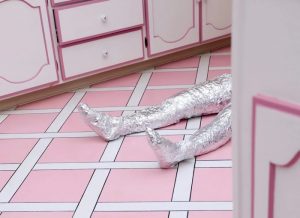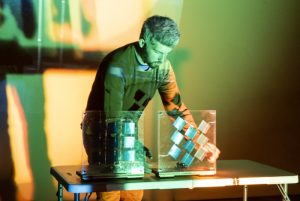The only thing i had ever seen of Ujino Muneteru was the poster of a rather fascinating sonic sculptural instrument he calls the Love Arm. It was 2 years ago at ars electronica. I keep hoping i’ll see more of his work one day but in the meantime, lucky me! Vicente Gutierrez managed to meet the artist and together with photographer Martin Holtkamp visited him in his studio. Here’s the result of their meeting:
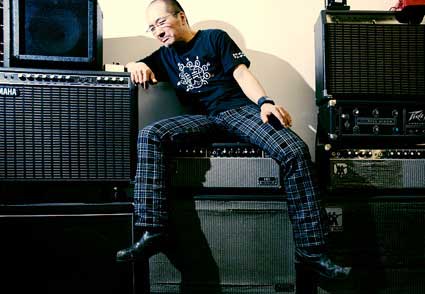 Muneteru in his studio, by Martin Holtkamp
Muneteru in his studio, by Martin Holtkamp
Tokyo based sound sculpture artist and performer Ujino Muneteru‘s Rotators is a giant tweaked-out jewelry box of modern and out-dated technology. While many old objects are ubiquitous in Muneteru’s work, its not the same old story of trash art. Muneteru works to discover new histories in material objects once discarded only to delicately care for them in hopes of restoring any sentimental value once lost. Tangled in Pop Art, Noise and some Dada, his conversions, performances and arrangements of junk and vintage are an insight into the role of materialism and what is of value in our lives- what is deemed junk or vintage or valid pop-iconography is largely up to the viewer. WMMNA caught up with Muneteru in his Tokyo studio to discuss the ‘Japan-ness’ of his work, all things junk and vintage and how dance culture fits into everything he does.
“my work is like plastic ikebana.”
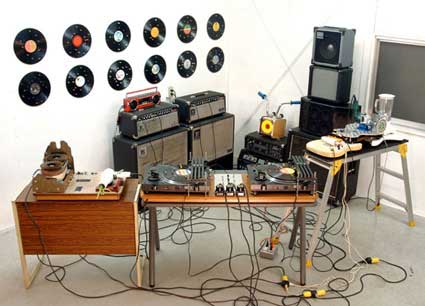 The Rotators. Photo: Masanori Ikeda, Courtesy of Muneteru.
The Rotators. Photo: Masanori Ikeda, Courtesy of Muneteru.
You just returned from the Beautiful New World exhibition in China…how was it?
Well, I was in Beijing for two weeks setting up an installation of the rotators for an exhibition at the Long March space as part of Beautiful New World, it was to celebrate the 35th anniversary of the relationship of The Japan Foundation with China. So I had set up the rotators to be there playing automatically. Before the exhibit, I did some shopping in China for some old materials for this exhibit to make it a little unique for China, like I did before in Vancouver. So, just like 10 days before the exhibit, in Beijing I bought an old drill, blender, vacuum cleaner and lots of lamps. I’d say that about 50% of the items were bought in China. In Vancouver, I bought 95% of the items for the rotators exhibit.
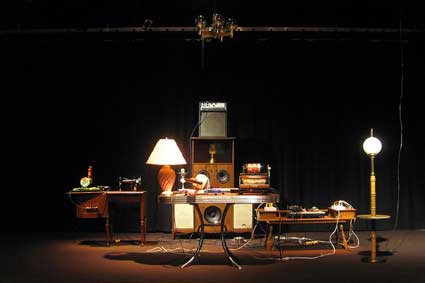 The Rotators ‘Robertson and Phillips’ at The Western Front, Vancouver,Canada. Courtesy of Munteru.
The Rotators ‘Robertson and Phillips’ at The Western Front, Vancouver,Canada. Courtesy of Munteru.
A lot of your work relies on old things, so was it easier to buy things in China or Vancouver?
I think it was easier in Vancouver. There’s just a longer sense of history of material things there. The part of people’s lives that is concerned with material things is longer in western culture, I feel. In China, there weren’t many second hand things- it was so hard to find old things or anything with sentimental value. Everything was so new and as soon as anything gets old, its thrown away or people sell whatever is metal to a steel company for melting these days. So a lot things are made of plastic. I mean, I’ve been to many modern cities in the east and west and that being my first time in China, everything was different and it was a challenge to collect older materials for my work.
Maybe in the future, in about 10 years or so, there will be more older things laying around to be used by someone else.
So how about in Japan?
Well, compared to western countries and China, both being foreign to Japan, well, I think we have a longer history of westernization. Westernization in Japan has been in effect longer so I think we’ve developed more of an appreciation of material things. Its a gradual process that takes years. With the way the cultural revolution went in China, I feel China’s economy boom is like catching up- they are quickly developing western sensibilities for western things. You can see that in how fast Shanghai developed into a major international city.
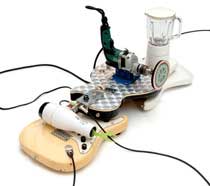 Platform for the Rotators. Photo: Masanori Ikeda, Courtesty of Muneteru
Platform for the Rotators. Photo: Masanori Ikeda, Courtesty of Muneteru
Ah, so how did Chinese people react to the rotators installation?
Well, people approached and looked at it as a mechanical piece. Like some strange kind of robot.
How does that compare to the way a Westerner would?
In Vancouver, visitors to the exhibit thought it was like someone’s grandmother’s home. I think their reaction was a bit more sentimental. Younger Chinese visitors seemed to be a lot more concentrated and their eyes were a fixed. I mean, they read more contemporary art related media like magazines and blogs and stuff- they tried to understand it or understood it and were at least sensitive to it but I thought that older people, especially those in the art world or ‘industry’, didn’t seem to care so much. The same is true for Japanese older generations, too. But anyways, one night, I had wanted to do a performance at the gallery but I couldn’t so we set up the rotators at a club- it was great, a great space too. You know, it was like a cool club in any big city but it felt like- well, in other cities, I feel that some spaces are divided by scenes, like a rock club is for rock and a house club is for house, etc, but this place was like a beautiful fusion of it all. What added to it all was that it was really small like a Japanese live house.
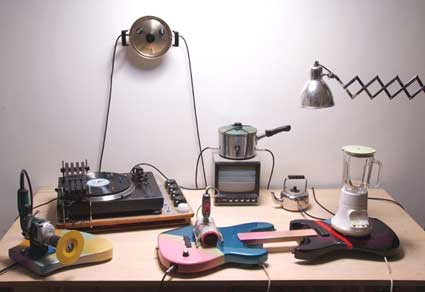 ‘The Savage’s Plastic Ikebana Session’ 2007. Photo: Masanori Ikeda, Courtesy of Muneteru
‘The Savage’s Plastic Ikebana Session’ 2007. Photo: Masanori Ikeda, Courtesy of Muneteru
You’ve adapted a new title for this particular installation of the rotators in Beijing, can you tell us a bit more about that?
Ah, the name, well, ‘the savages’ has a couple meanings, the first is referring to media art. A lot of the artists that were part of the Beautiful New World exhibit use computers or newer technology in their works and well, I don’t. The technology I use is pre-1985 so it’s a reference to being somewhat archaic, uncivilized and to a point- savage.
The other way of looking at the name is that it is a reference to an ancient tale of China and Japan, like 2000 years ago, it’s kind of a long and messy story, but it really did influence the naming of this particular exhibit.
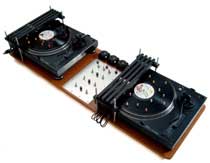 The Rotatorhead which controls it all. Photo Masanori Ikeda, Courtesy of Muneteru
The Rotatorhead which controls it all. Photo Masanori Ikeda, Courtesy of Muneteru
Great, back to rotators for a minute…a majority of the materials in your work are western, and if I didn’t know you were Japanese upon viewing your work, how would I know this was done by a Japanese artist? What is Japanese about your work?
Well, It’s really easy to get lots of objects for my work in Japan because there’s so much old technology laying around in old recycle electronic shops. Every time i find and buy old junk things, I want to clean them up and polish them, make them nice again- presentable. The fact that there are many western things in the rotators, clicks with the idea of it being like a grandmother’s room- you can get the sense that these things are or were precious because they had a home, they were once loved.
I think I put some love into combining and assembling them in such a way that in the end it’s a sound sculpture. But I think my work is very neat, clean, organized and the layout is very proper. It’s like a japanese bento, ya know? [laughs] Very organized, its own structure and aesthetic is present there. When I have assistants helping me, I tell them, “make it like a Japanese bento.” Sometimes I say my work is like plastic ikebana because of its precise arrangement.
You said it so easy to get things in Japan because of a high turnover and I’m thinking- is there a relationship in your work to the record levels of mass consumerism in Japan?
Japanese people want to have the latest thing so they buy what’s new and ditch the old at recycle shops. In this area, there are so many recycling shops that are formal companies, they have many trucks and assemble and gather peoples old goods for sale in shops, there is so much recycling going on here and that works out for me. I like to take that junk and re use it.
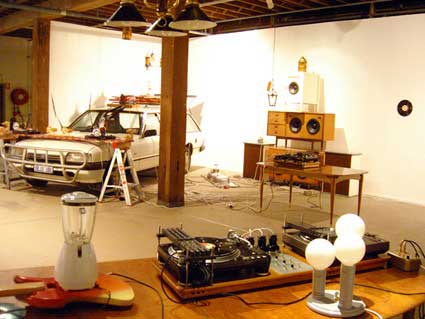 Another shot of The Rotators. Courtesy of Muneteru
Another shot of The Rotators. Courtesy of Muneteru
So do you see a difference in what is junk and what is vintage?
Some junk or cheap things may be vintage in a few years as they appreciate over time, but thats an interesting point, I will say that everything in the rotators is junk!
I read on your website, “the neatness and cleanliness are a very core of Japanese authentic beauty…a wild chaos can only exist as the subject of exoticism.”
Yeah, thats true, I like it, I need it.
Ok. what’s the message in rotators?
Well, its DIY. With an emphasis on physical means- just using your hands and body to make your own things- sculptures or instruments- using technology in your own way and not letting it dictate function. You know, its like a computer, the keyboard is made for your fingers, and we shouldn’t limit our thinking to that way. I try to find the opposite way and do it. With the rotators, I feel I am reversing that relationship, that I am in control of technology, not vice versa.
But everywhere I look technology is getting more function specific and smaller? that’s good, no?
Well, especially, in Japan! Japan excels at making things smaller and for now, thats the direction most technology is going, smaller and smaller, micro and nano. But I think it’s too small for people and we’re leaving something out. I remember in 1978, at a video game arcade, I saw an arcade game booth drop set into a table, like a sit down cabinet and that changed video games forever, since then, things have been getting smaller and smaller, but there are ergonomic limits, you know? I don’t like using small buttons, I like older stuff, things that truly follow the human form for function. I mean, in the cyber world, there is no weight, nothing physical, no heaviness, and I like using real, bulky things, I don’t want to lose that.
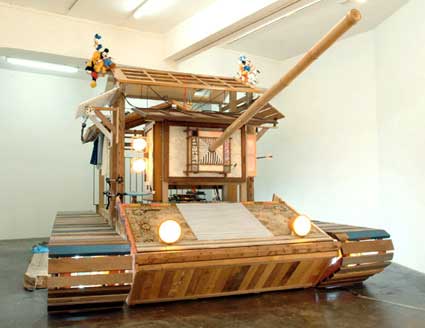 Ozone – So Provided by Mizuma Art Gallery. Courtesy of Munteru
Ozone – So Provided by Mizuma Art Gallery. Courtesy of Munteru
So is rotators a toy or musical instrument? Is it interactive?
No, it is not interactive, but I want to make it more interactive in the future and work in that direction, I am planning and working on a human-scale, ergonomic, drum machine. Interactive is next!
Ok, I have to ask you, you mentioned dance culture as an influence in your work, please explain!
Well, I like drum machines. I love the beats. And I’m interested in making sounds, especially sounds with a groove. I want to make music and do live performances and its all about the beat in dance so I like to use low frequency sounds, like using a blender- it gives off a nice low sound. And about dance music, well, I like thicker, more embellished beats like Prince- he had an influence on me in terms of the music.
I wanted to make, I wanted a groove.
Great! So what’s next for you and rotators?
Well, I’ve got a live performance coming up soon, with Chim Pom, this young art collective. Two of the members used to be my assistants a few years ago when I was making Ozone-so, Ryuta Ushiro and Yasuyaka Hayashi. Other members are students of Aida Makoto. That’s Chim Pom and they have a different way of making music but its really physical and focuses on objects too, in a realistic way. So we’re going to have a live performance together. I’m thinking of a Berlin exhibit next year.
 Flyer for Sunday’s performance. Courtesy of Muneteru
Flyer for Sunday’s performance. Courtesy of Muneteru
And any news on the Love Arm series or ozone-so for fans out there?
Well, I am not working on it now because i’ve been so busy with the rotators but in the future I will for sure continue it and work on Love Arm number 5, haven’t started yet, but I will. And ozone-so is currently being exhibited in Germany now, and it will be exhibited in Berlin next year, in March, I’ll go there to do a live performance too.
The live performance with Chim Pom will be Sunday the 28th!
at Open studio *3.0 in Tokyo. And on December 22nd, I’ll be performing in Harajuku at the LaForet museum with several other performers.
Thanks so much Ujino for sharing and discussing ideas in your work- we had a great time at your studio! Thanks!

